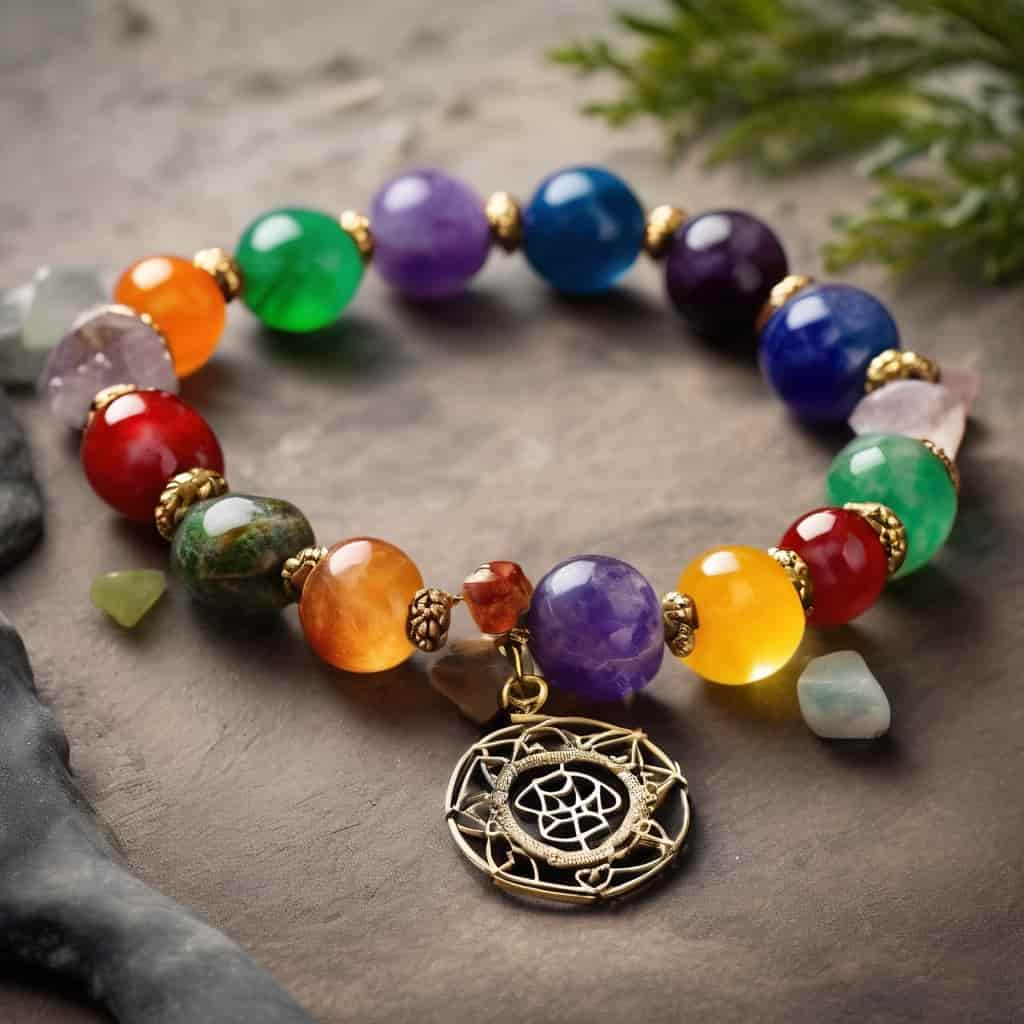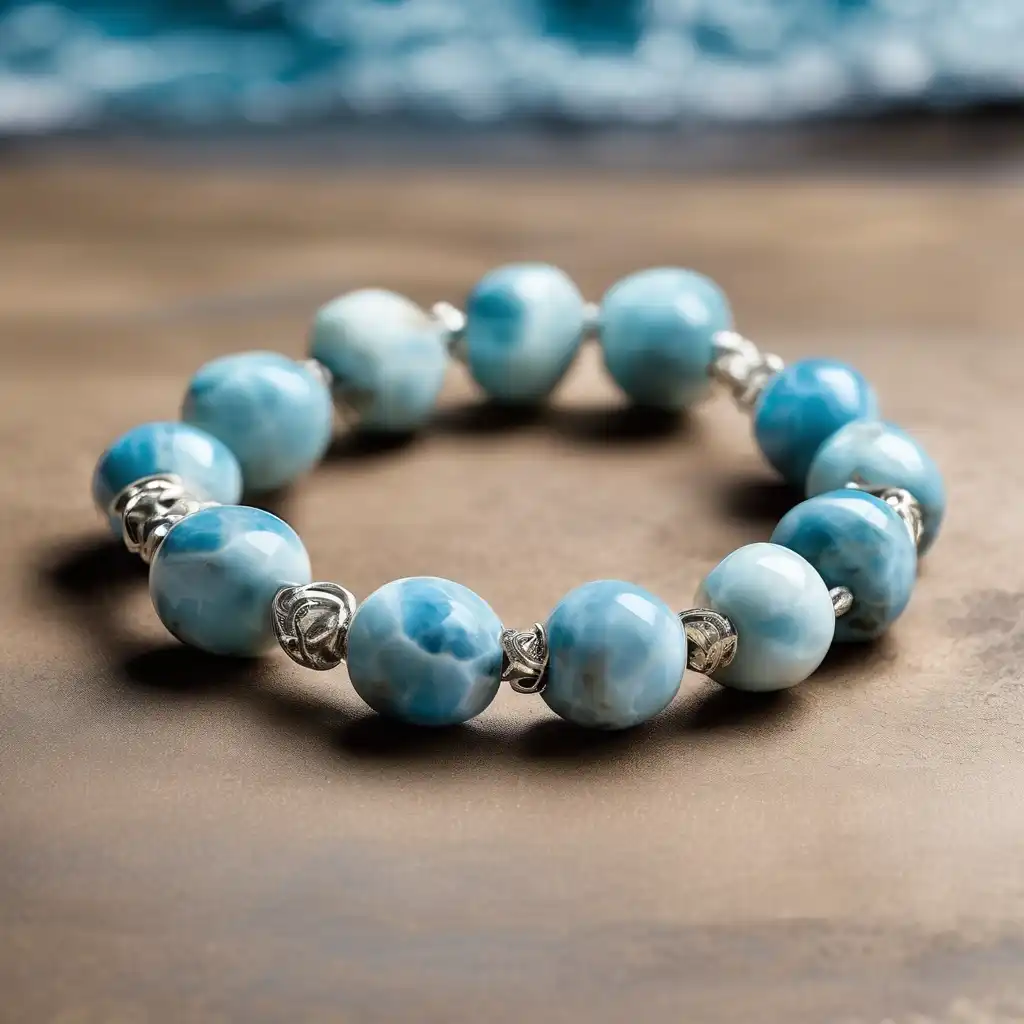Types of Gemstone Beads – A Complete Guide for Jewelry Enthusiasts
Understanding the World of Gemstone Beads
The Allure of Gemstone Beads in Jewelry Making
Gemstone beads aren’t just beautiful—they’re expressive. Each one carries the story of time, pressure, and transformation deep beneath the earth. Whether you’re working on your first bracelet or a complex multi-strand necklace, the types of gemstone beads you choose play a giant role in how the finished piece will look, feel, and even function.
From rough and rustic to smooth and high-polish, these beads offer flexibility that no synthetic alternative can quite match. That’s why they’re so beloved across different jewelry styles—classic, minimalist, boho, spiritual, or luxury.
Why Gemstone Beads Appeal to Everyone
No matter the budget or design vision, gemstone beads offer something for everyone. You’ll find them in craft shops and luxury showrooms alike. People love them for their color, pattern, and the types of gemstone beads they can explore—stones with energy, personality, and purpose.
Take rose quartz, for example. It’s soft, gentle, and believed to promote love. Lava stone, on the other hand, has a raw texture and masculine edge—great for grounding or pairing with essential oils. These varied types of gemstone beads let designers create pieces that feel highly personal. You’re not just choosing a look—you’re choosing a mood, or even an intention.
They also fit a wide range of technical needs. You can wire-wrap them, string them, knot them, or even stitch them into embroidery. Sizes go from tiny 2mm spacers to large statement beads. Want a sleek, polished 6mm black onyx strand for a men’s bracelet? Easy. Prefer irregular, earthy 10mm turquoise nuggets for a necklace? Also available. There’s room to experiment.
Gemstone beads serve as tools for personal expression.
The Spiritual and Healing Significance of Beads
For many wearers and makers, gemstone beads hold more profound meaning. Whether it’s about protection, energy, or emotional healing, certain stones have become go-to choices for specific intentions. And when you understand the types of gemstone beads available, you can begin choosing stones that resonate on a personal level—not just aesthetically.
- Tiger Eye: for confidence, mental clarity, and courage
- Amethyst: for calmness, sleep, and spiritual focus
- Black Tourmaline: for protection and grounding
- Moonstone: for emotional balance and intuition
Even people who don’t believe in “crystal energy” often find comfort in knowing their jewelry symbolizes something meaningful. Occasionally, that symbolism is all you need.
Designing with Intent
One of the most beautiful things about gemstone beads is that they allow you to design with purpose. When choosing among different types of gemstone beads, you might ask, What do I want this piece to express? Strength? Love? Joy? Protection?
Let’s say you’re making a necklace for someone who just started a new job. You might combine citrine for confidence and lapis lazuli for communication. Could you design a bracelet to aid someone recovering from a breakup? Rose quartz and lepidolite might be perfect. These stones help tell a story—and the jewelry becomes more than a fashion item.
Shapes, sizes, and varieties of gemstone beads are diverse.
What Makes Each Type Unique?
Not all gemstone beads are made equally. The types of gemstone beads vary not only by material but also in cut, polish, shape, and origin. Some stones—like agate or jasper—reveal intricate banding. Others, like clear quartz or fluorite, play with transparency and light.
Their shape affects the design too:
- Round beads are classic and versatile.
- Chips give a raw, natural texture.
- Teardrops work well for earrings or pendants.
- Cubes and faceted rounds add a modern edge.
By mixing shapes, textures, and sizes, you create more than just a necklace—you build contrast, movement, and balance. And as you experiment with more types of gemstone beads, you’ll start to discover combinations that just “click”—both visually and emotionally.
How to Classify Gemstone Beads – Beyond Just Looks
Breaking Down the Materials: From Earth to Organic Origins
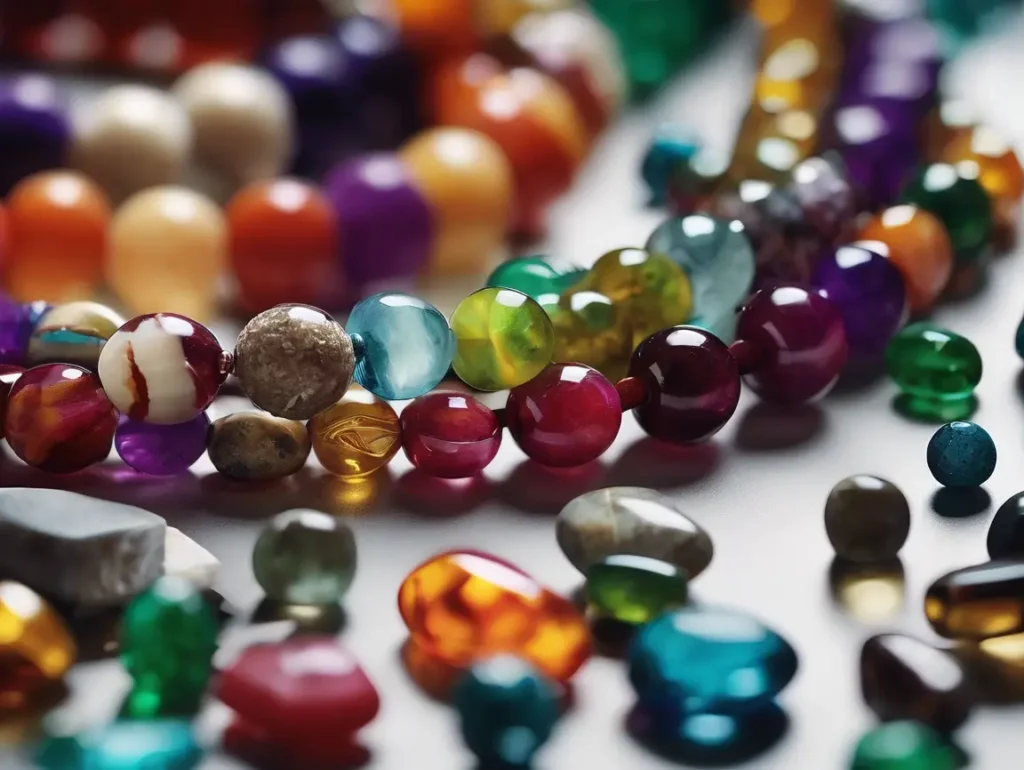
Understanding the materials behind different types of gemstone beads is the first real step to appreciating their depth. Not all gemstone beads come from hard rocks—some are fossils, some are crystallized resin, and some come from living organisms.
Mineral-based gemstone beads are what most people think of: quartz, garnet, jade, or labradorite. Deep underground, heat and pressure have shaped these stones over millions of years. When you hold one, you’re literally holding a piece of geological history.
Then you have organic beads—amber, pearl, coral, and jet. These don’t crystallize the same way minerals do, but they still count as gemstones in the jewelry world. Amber is fossilized tree resin, pearl comes from mollusks, and coral grows in the sea. They’re softer and sometimes more fragile, but their texture and warmth offer a different kind of charm. Choosing from these types of gemstone beads depends as much on feel as it does on meaning.
Precious vs Semi-Precious—Does It Really Matter Anymore?
Traditionally, people divided stones into precious and semi-precious. Diamonds, rubies, emeralds, and sapphires made the “precious” list—everything else got grouped as semi-precious. However, the distinction between precious and semi-precious stones has become less clear in modern times. Some semi-precious stones, like larimar or moldavite, can be rarer than rubies.
In handmade jewelry and beadwork, most of the action happens with the so-called semi-precious stones. They’re diverse, affordable, and available in a wide variety of finishes and shapes. Most popular types of gemstone beads fall into this category, and for good reason—they’re intriguing, beautiful, and full of character.
What Are the Five Types of Beads You Should Know?
So, what are five bead types that every beginner should try?
- Quartz beads: clear quartz, rose quartz, amethyst, citrine
- Agate family: moss agate, blue lace agate, fire agate
- Jasper variations: dalmatian jasper, red jasper, mookaite
- Feldspar group: moonstone, labradorite, sunstone
- Organics: amber, pearl, coral, jet
These core categories cover most of the common types of gemstone beads you’ll see in the market. They give you color, texture, and energy—and so many design directions to explore.
Real, Synthetic, or Fake—What’s the Difference?
One of the most important things to understand in the world of types of gemstone beads is the difference between what’s real, what’s synthetic, and what’s just made to look genuine.
- Natural beads are precisely what they sound like—stones formed in nature, sometimes treated or polished, but fundamentally unchanged.
- Synthetic beads are lab-created versions of real stones. A synthetic sapphire has the same chemical makeup as one from the earth—it’s just man-made.
- Imitation beads aren’t gemstones at all. They may consist of dyed glass, plastic, or resin. They may look great from a distance, but they won’t hold energy, value, or durability.
And there’s nothing wrong with using imitation beads in the right context. But you should know what you’re working with. If you’re telling your customer they’re buying natural stones, they need to be exactly that. As you handle more and more types of gemstone beads, your eye and touch will become more accurate—you’ll start spotting inconsistencies in polish, temperature, or even the way the bead reflects light.
The Role of Treatment and Enhancement
Treatment is a common practice for certain stones. Heat brings out the purple amethyst. Dye enhances the layers in agate. Resin fills cracks in turquoise or chrysocolla to prevent breaking. These treatments don’t mean a stone is fake—but again, disclosure matters.
If a supplier does not clearly list treatments, please inquire for more information. And if they can’t give a straight answer, find one who can. Transparency is key when working with any types of gemstone beads.
How Can You Tell What You’re Really Working With?
Understanding classification helps you design with purpose.
Knowing your stone types helps you match them with intention. Want something grounding? Go for dark stones like obsidian or hematite. Want to design for emotional healing? Try rose quartz, amazonite, or lepidolite. Understanding the materials also lets you pair stones more effectively—harder with softer, rough with polished, matte with shimmer.
As you grow more familiar with different types of gemstone beads, your confidence grows. You stop guessing and start designing with purpose. Whether you’re stringing beads for sale or as a meditative hobby, it just feels better when you know exactly what’s in your hands—and why you chose it.
How to Identify Gemstone Beads – Tips, Tools, and Practical Steps
Learning to Spot the Real from the Replicas
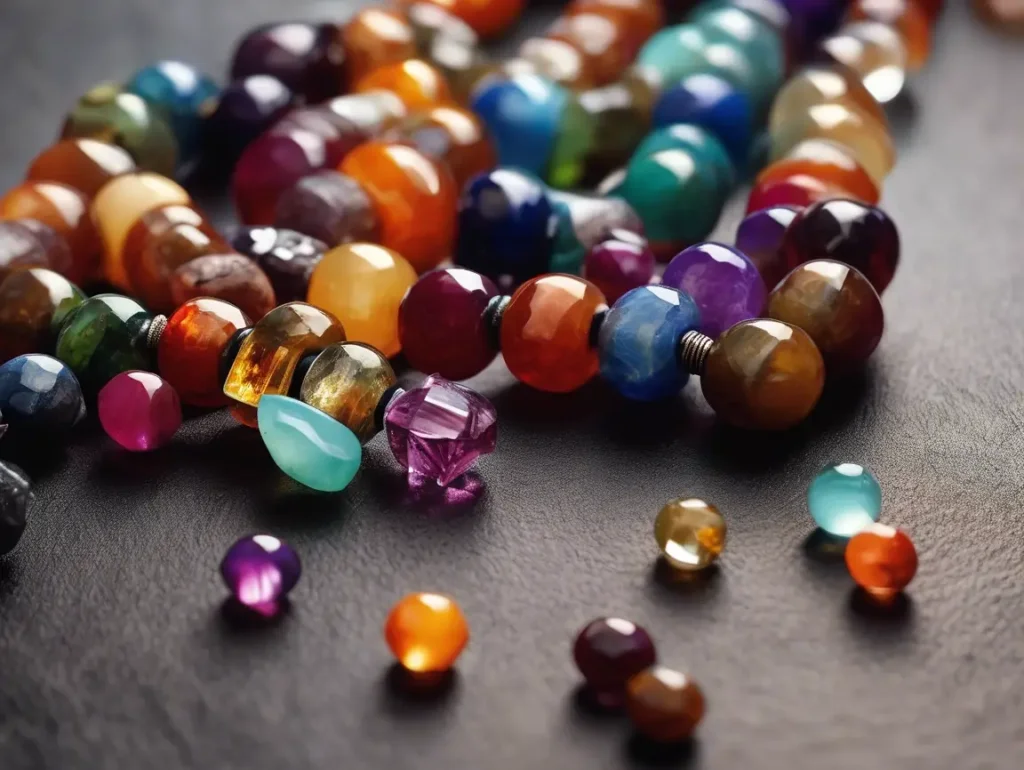
One of the trickiest but most rewarding parts of working with gemstone beads is learning how to tell what’s real and what’s not. With so many types of gemstone beads available—natural, dyed, synthetic, and imitation—it’s easy to fall for deception if you’re not paying close attention.
But the good news is, you don’t need a lab or gemology degree to get better at identifying your stones. A skilled eye, your hands, and a few low-tech tools can take you surprisingly far.
Use Your Eyes First—Color, Pattern, and Inclusions
Start with simple observation. Natural gemstone beads often have slight imperfections. Look closely, and you’ll see cloudy zones, tiny internal fractures, or changes in color tone. These are positive signs—they show the bead came from the earth and not a factory mold.
Too perfect? Too bright? Every single bead is identical? This raises serious concerns. Many fake or synthetic types of gemstone beads are dyed to achieve a vivid, uniform color. Turquoise is one of the most commonly faked—real turquoise is rarely that bright robin’s egg blue you see on cheap strands.
For agates, jaspers, or quartz-based stones, look for natural banding or subtle shifts in color. Those patterns are difficult to fake convincingly.
Feel the Weight and Temperature
Real gemstone beads are heavier than plastic or resin. When you hold them in your palm, they feel cool to the touch and take a little time to warm up. That’s a signature trait of mineral-based stones.
Imitation beads—especially acrylics or glass—usually warm up right away and feel oddly lightweight. Even if they look like natural types of gemstone beads, they don’t behave like them physically.
Furthermore, the surface finish gives clues. Natural stones are smooth but not slippery or waxy unless coated. If a bead feels too slick or the polish looks overly shiny, it could be treated or fake.
Use Basic Tools to Double-Check
You don’t need high-end equipment to get better at identifying types of gemstone beads. These five tools are all you need for quick, at-home checking:
- Magnifying glass or jeweler’s loupe—spot inclusions or polish marks
- Mohs hardness kit—helps test resistance to scratching (e.g., quartz should scratch glass)
- UV flashlight—amber fluoresces; some dyed stones reveal weird glows.
- Digital scale—helps compare densities across stones of similar size
- The phone app, such as Rock Identifier, can provide suggestions, although it is not 100% reliable.
While none of these tools are definitive on their own, they’re incredibly helpful when used together—especially when paired with real-world experience.
Trust Your Sources
It’s crucial to remember who you purchase from. Reputable sellers clearly state if a stone is dyed, stabilized, synthetic, or natural. They offer transparency about treatment and don’t overhype what the stone can do.
If a site is selling “genuine sapphire beads” for $5 a strand, ask questions. Understanding the various types of gemstone beads enhances your ability to identify potentially fraudulent deals.
And if you’re reselling, your knowledge matters even more. Mislabeling stones can hurt your brand and credibility. Customers these days are more educated—they’ll notice when something feels off.
Why Is Practice the Best Teacher?
There’s no shortcut here—identifying gemstone beads is a skill that grows with time. The more strands you handle, the better your intuition gets. You’ll start to feel the difference between dyed howlite and real turquoise. You’ll notice when a “moonstone” doesn’t have adularescence or when “jade” feels too light to be nephrite or jadeite.
What’s the best part? You start appreciating the subtle details—the cloudy line inside rose quartz, the shimmer in labradorite, the stripes in tiger eye. The variety in types of gemstone beads becomes a source of joy instead of confusion.
And when you hand someone a bracelet and can say with confidence, “This is real garnet from India, not glass,” that confidence shows up in your craftsmanship too.
Healing Properties of Popular Gemstone Beads
Why We Wear Stones—Beyond Beauty
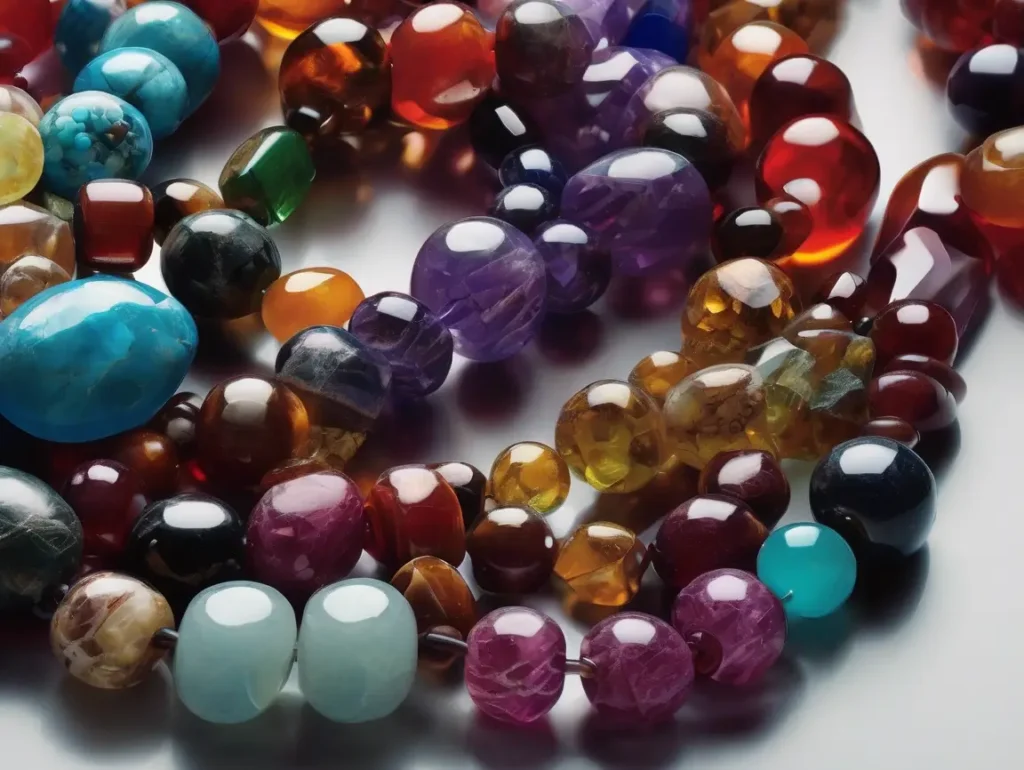
Gemstone jewelry isn’t just about color or sparkle—it’s deeply personal. Many people wear beads not only to match an outfit but also to soothe emotions, boost energy, or serve as a silent source of strength. That’s part of the magic behind different types of gemstone beads: each one carries its mood, story, and symbolic power.
While science hasn’t confirmed all the healing claims, many people swear by their favorite stones. Whether it’s a comfort ritual or a source of inner focus, the act of choosing a specific bead—consciously and with intention—gives it power.
Amber—For Soothing and Letting Go
Amber is unique among the many types of gemstone beads. It’s not a stone at all, but fossilized tree resin, often golden or honey-toned. Lightweight and warm to the touch, amber is believed to absorb negative energy and offer emotional relief.
Parents of teething babies often wear it, but adults also wear it—especially to ease stress, body tension, or feelings of heaviness. The natural warmth of amber makes it comforting, and when worn close to the skin, many say it helps them release old emotional baggage.
Amethyst, Citrine, and Aquamarine—Stones of the Mind and Emotions
Each of these stones offers a specific kind of emotional support, which is why they’re among the most popular types of gemstone beads in healing jewelry.
- Amethyst is known for calming the mind. It’s ideal for easing anxiety, improving sleep, or helping with clarity when life feels noisy.
- Citrine brings brightness. It’s tied to joy, creativity, and abundance—perfect for people starting a new job or creative project.
- Aquamarine supports emotional communication. It’s believed to soothe grief, fear, and emotional blockage while opening the throat chakra.
What connects these beads is their emotional intelligence. They’re the soft-spoken guides in the gemstone world—stones that help you breathe a little deeper.
Garnet and Moonstone—Strength and Intuition in Daily Life
Some stones show up when you need energy and focus, others when you need emotional balance. Garnet is fiery, often deep red, and associated with motivation and physical vitality. If you’re facing burnout or low drive, garnet can be the push you need.
Moonstone, on the other hand, invites reflection. It’s linked to intuition, dreamwork, and emotional clarity. Its soft shimmer almost feels like it’s breathing. A favorite among those looking for calm, moonstone beads are ideal for meditation or evening wear.
People often wear these two contrasting types of gemstone beads together, with garnet grounding you and moonstone elevating your emotional awareness.
Rose Quartz and Pearl—Heart-Centered Healing
Soft in appearance but powerful in meaning, these two stones focus on love and inner peace.
- Rose quartz is all about self-love, emotional healing, and compassion. It’s often worn after heartbreak or during periods of emotional growth.
- Pearls, while technically organic, are often used in gemstone bead jewelry for their calming and nurturing qualities. In Eastern cultures, they’ve long symbolized wisdom, serenity, and even physical healing.
Both beads work beautifully in everyday designs and chakra-style bracelets. Their gentle energy makes them ideal for people who want to feel safe and emotionally supported—two of the most common goals among users of healing-focused types of gemstone beads.
Matching Stones to Your Daily Energy
There’s no rulebook for choosing healing stones. You don’t need to follow a strict chart or believe in every metaphysical claim. Occasionally, the best way to pick from the many types of gemstone beads is to simply hold them and see what draws you in.
A soft pink might feel right one day, and a bold black the next. That’s okay. Jewelry doesn’t have to be just fashion—it can be a reflection of your current state of mind.
And when you start designing with this kind of awareness, something shifts. Your pieces stop being accessories and start becoming companions. You’ll find customers connecting to your designs not just because they look good, but because they feel something deeper—and that’s where the real value lies.
Buying Guide and Final Thoughts—Choosing the Right Gemstone Beads
Where and How to Buy Quality Gemstone Beads
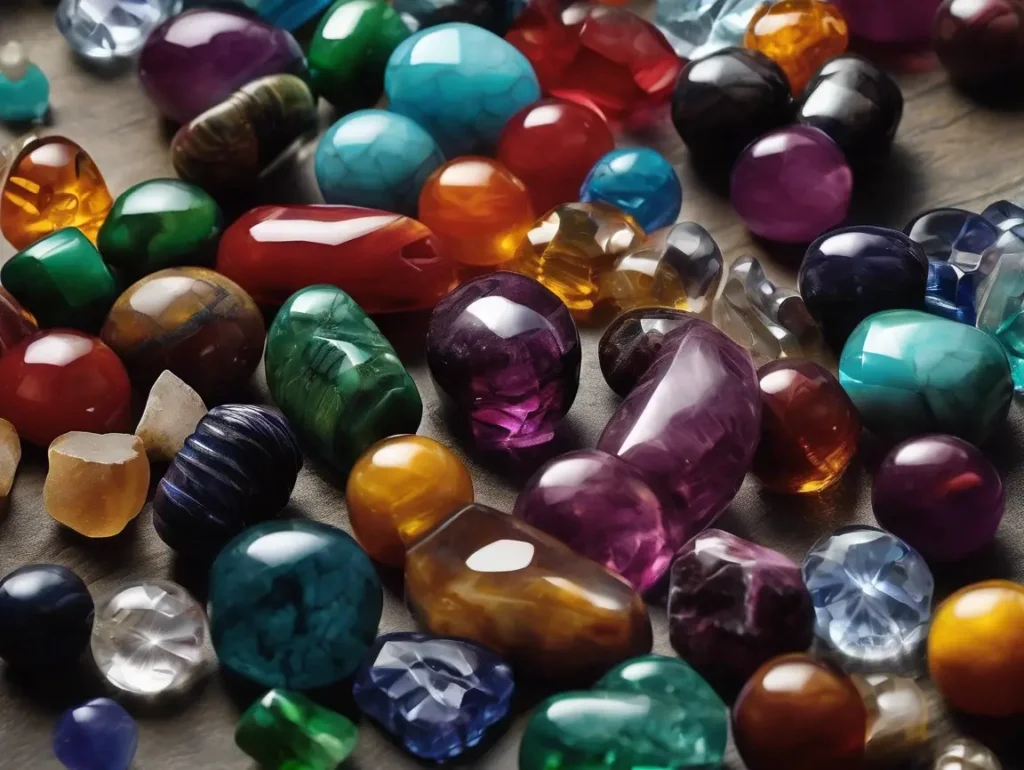
After you’ve explored the meanings, textures, and emotional value of different types of gemstone beads, the next step is finding the right place to source them. And that’s a journey in itself.
Whether you’re buying online or browsing at a gem fair, one rule remains the same: know your source. A good supplier won’t just show you pretty photos—they’ll explain where the stones come from, whether they’re natural, treated, or synthetic, and what each bead is made of. If you’re serious about beading, particularly for resale or gifting, it’s imperative to collaborate with reliable sellers.
Shops like The Bead Traders, Fire Mountain Gems, and specialty vendors on Etsy often offer wide selections and clear labeling. They carry dozens of different types of gemstone beads, from common favorites to niche varieties you might not even recognize at first glance.
When shopping, don’t be afraid to ask:
- Are these beads dyed or stabilized?
- Is this real turquoise or dyed howlite?
- Where were these stones sourced?
The more questions you ask, the more confidence you’ll have when creating with them.
Tips for Picking the Right Stones for Your Designs
What to Look For When Shopping for Beads
Designing with gemstone beads is deeply personal. You’re not just picking colors—you’re picking energy, symbolism, and feel. That’s why the types of gemstone beads you choose should support both your artistic vision and the wearer’s emotional needs.
Here are some things to look for as you shop:
- Visual variation: Natural beads often have small quirks—color zoning, streaks, and internal flecks—that make each one feel alive.
- Weight and texture: Heft matters. Real stones have a density and coolness to them. Light and plastic-feeling beads are usually fake.
- Hole quality: If you’re hand-knotting or using fine thread, make sure the drill holes are clean and centered.
- Cut and polish: Decide if you want smooth, tumbled finishes or faceted shine. Some types of gemstone beads (like sunstone or labradorite) come alive when faceted just right.
Matching the technical aspects with the emotional tone is where your designs start to shine. A matte black onyx bracelet gives a different vibe than a high-gloss one—same stone, different feel.
Why Do Shape, Origin, and Energy All Matter?
From Nuggets to Hearts—Choosing with Intention
The same stone can communicate something entirely different depending on its shape. A round rose quartz bead feels gentle and balanced. A raw chunk of rose quartz strung like a pendant feels wild and raw. That’s why experienced designers pay attention to both material and form.
Here are some popular shape choices:
- Round—classic, balanced
- Chips or nuggets—organic, earthy
- Teardrops—elegant, flowing
- Cubes or hexagons—modern, structured
- Hearts or symbols—expressive, emotional
Likewise, origin can play a role in the quality and feel of the stone. Madagascar labradorite often flashes more brightly than other varieties. Mexican fire opal has more fiery orange. Sri Lankan moonstone is generally more translucent. As you work with more types of gemstone beads, you’ll notice these subtle differences and develop preferences.
And then there’s energy. Some people choose stones based on how they want to feel: strong, calm, creative, or protected. Others match stones to their birth month, zodiac sign, or spiritual path. Whatever your reason, selecting beads with intention makes the finished piece more meaningful—for both maker and wearer.
Mixing Stones—Combining Beauty with Meaning
The most powerful jewelry pieces often come from mixing several stones together. Combining different types of gemstone beads can help balance energies or simply create more dynamic visual impact.
Want grounding and clarity? Try black tourmaline with clear quartz. Need love and protection? Consider combining rose quartz with hematite. Are you seeking mental clarity and tranquility? Consider combining amethyst with fluorite. There are no hard rules—only what feels right.
Currently, some of the most popular bracelets and necklaces on the market incorporate two to four different stones in a single piece. When chosen with care, these combinations can tell stories and evoke emotions that a single bead never could.
Final Thoughts—Let the Stones Speak for Themselves
The world of gemstone beads is as deep and colorful as the earth itself. From shimmering labradorite to soft pink morganite, matte lava stone to polished tiger eye—each type of bead holds something unique.
Learning how to choose the right types of gemstone beads means listening—to the stone, to the person who will wear it, and to yourself. It’s not always about what’s trendy. Occasionally, the stone that speaks to you is the one you didn’t plan to buy. And that’s the beauty of this craft—it’s part design, part intuition.
Whether you’re creating to sell, to gift, or for personal healing, remember: the beads you choose aren’t just decoration. They’re tools for expression, memory, and intention. And when you work with the right stones, you don’t just make jewelry—you tell a story.
FAQ—Frequently Asked Questions
How do I identify my gemstones?
Start with basic observations—look at the texture, color patterns, and weight. Natural gemstone beads usually have small imperfections or inclusions. Once you’re familiar with different types of gemstone beads, spotting the genuine ones becomes much easier.
How do I know what kind of beads I have?
Feel the weight, check the polish, and use a loupe to look inside the stone. Compare with verified images or samples. If you’re working with common types of gemstone beads, resources online can often help you match the visual traits.
How to identify original ruby beads?
Natural ruby beads are heavier than glass, usually with visible inclusions or uneven color. Perfect uniformity often means synthetic or fake.
Is there an app to identify stones in jewelry?
Apps like Rock Identifier can help suggest options, but manual inspection remains more reliable.
Conclusion—Your Creative Journey with Gemstone Beads Starts Here
Jewelry-making with natural stones is more than just design—it’s about meaning, memory, and energy. From soothing rose quartz to protective black tourmaline, each stone offers something unique. And among the many materials you’ll work with, few are as rich in variety and character as the types of gemstone beads you choose for your pieces.
Whether you’re creating for yourself or for others, let the beads guide the story. The right stones don’t just enhance your design—they reflect your intention, your values, and your creativity.

